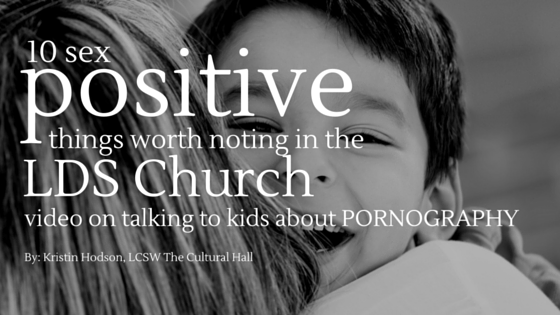A few months ago the Church of Jesus Christ of Latter-Day Saints released a new YouTube video on the topic of talking to kids about pornography. However, after watching it several times, it actually covers much more. This video made the social media rounds for a couple of weeks and received some well-earned praise, but, in my opinion, it deserved more. So much was packed into this four minute little film that I think, if only watched once, it was easy to miss all the really great secondary messages.
Was it perfect? No. But was it a huge step in the right direction in starting to change how we talk about sexuality in the church? Yes! Imagine going back to when you were seven, eight or nine and being shown this video. Then imagine potentially having many conversations with your parents about your developing body, your curiosities, your questions, clarifying something you heard from your friend at school. How would you be approaching your relationships now? How would you feel in your own body? Imagine having your development start like this and envision how that could have changed some of the circumstances and challenges you face now. So without further ado, here are the Top 10 things I thought were big steps in fostering healthier conversations about sex in our church:
- The acknowledgement of pleasure: Pleasure has long been a taboo topic and something that has been completely absent in conversations around sexuality. In this video, they practice what they preach by calling it what it is and including it in the normal, sexual human experience.
- Having both boys and girls narrate the video: Both in church teachings and within church culture, boys and men have been seen as the ones with the sexual drive and desire while girls and women are to be desired and desirable. Having both boys and girls narrate this video acknowledges that all genders have sexual desire, sexual curiosity AND that pornography isn’t just a problem for boys.
- Normalizing curiosity: From the moment we are born we are curious about the world around us; noticing that we can wiggle our fingers, we are curious about different foods and of course being curious about our bodies and all they can do. Acknowledging that being curious about sex is just as normal as being curious about why the sky is blue takes away the shame and fear and empowers us to channel the curiosity in healthy ways.
- Not using shame or scare tactics: Finally a video that doesn’t give us dire statistics about the tragedy of pornography use or somehow weave in something about Ted Bundy! It clearly states that kids aren’t “bad” for looking, being curious or wanting to continue to look (See #3 again, let’s channel and redirect that curiosity through ongoing conversations!)
- Having younger children narrate the video: Something I have heard many parents say about this video is, “I was surprised by how young the kids were in the video!” Sending the message that we need to start talking to our kids about sexuality earlier than we think helps us to confront our own discomforts and fears and start having conversations and teaching.
- Addressing a variety of sexual health topics: After watching this video countless of times, while they focused on pornography, this video addressed a variety of other sexual health topics that we need to talk to our kids about to confront pornography including: health and hygiene, emotions, boundaries, pleasure, body image, anatomy and healthy sexual development, safety and relationships.
- The number of times they emphasize teaching: In this video, they really placed a lot of emphasis on the need and responsibility we have to teach our children about sexuality. In fact, I counted 11 different times they reference teaching! We have the opportunity to help shape our kids’ perceptions around sexuality and have the privilege to teach them in our home if we choose to take the opportunities.
- Providing skills to help kids negotiate difficult situations: Using the metaphor of the ocean, we don’t expect someone to know how to stay safe in the ocean with little to no instruction. As with sexuality, we can’t expect our children to simply honor the values we have or that we have taught them or to navigate challenging situations without giving them the skills to do so.
- Acknowledging sexuality is a part of life: So refreshing to hear that we are sexual beings from the moment we are born rather than somehow turn on sexually like a light switch once we are adults. This doesn’t mean that childhood sexuality is the same as adult sexuality, it means that we develop according to our age, going through different stages like anything else. We are curious about our bodies, experience pleasure, want connection in relationships and friendships, want to express our gender and more.
- Healthy and happy relationships: Lastly, I loved the emphasis on happy and healthy relationships. Just like teaching our children about money when they are young if we want them to grow up to be financially responsible adults or how to cook if we want them to develop a basic life skills, if we want our children to have happy, healthy adults relationships we have start teaching and preparing them when they are young. And teaching them about sexuality is a big part of that.
What things did you notice? We’d love to hear!
_______________________________________________________________________________
 Kristin Hodson is Co-Founder of the soon-to-launch website Sex Made Simple, is Founder and Executive Director of The Healing Group mental health clinic in Salt Lake City and Co-Author of the book Real Intimacy: A Couples Guide for Genuine, Healthy Sexuality (Cedar Fort 2011). She has spent over three years exclusively studying human sexuality learning from the best across the country. One of her favorite things to do is bridge things that don’t seemingly go together like sex and religion. In fact she was once hired to speak at a Valentine’s corporate event and was given these parameters: “We will have Mormon Bishops to people who swing. Make it work.” And make it work she did. She’s often asked to speak in the community and religious groups because of this. She has a unique ability to break down the topics of sexuality into easily digestible pieces empowering people to further develop their sexual identity, hone their sexual values, improve their communication around sexuality all with the intention to improve people’s relationships with themselves and others. She’s approachable, relatable and has a light sense of humor around something that often feels intimidating or heavy. She has been an expert speaker national trainings led by Sex Therapists Dr. Gina Ogden and Tammy Nelson, has contributed to Sheknows.com, Women’s Day Magazine, The Deseret News, was a regular guest on the x96 on the Radio From Hell show taking live calls on sex and intimacy and has regularly appeared on KSL’s Studio 5, on KUTV 2 news.
Kristin Hodson is Co-Founder of the soon-to-launch website Sex Made Simple, is Founder and Executive Director of The Healing Group mental health clinic in Salt Lake City and Co-Author of the book Real Intimacy: A Couples Guide for Genuine, Healthy Sexuality (Cedar Fort 2011). She has spent over three years exclusively studying human sexuality learning from the best across the country. One of her favorite things to do is bridge things that don’t seemingly go together like sex and religion. In fact she was once hired to speak at a Valentine’s corporate event and was given these parameters: “We will have Mormon Bishops to people who swing. Make it work.” And make it work she did. She’s often asked to speak in the community and religious groups because of this. She has a unique ability to break down the topics of sexuality into easily digestible pieces empowering people to further develop their sexual identity, hone their sexual values, improve their communication around sexuality all with the intention to improve people’s relationships with themselves and others. She’s approachable, relatable and has a light sense of humor around something that often feels intimidating or heavy. She has been an expert speaker national trainings led by Sex Therapists Dr. Gina Ogden and Tammy Nelson, has contributed to Sheknows.com, Women’s Day Magazine, The Deseret News, was a regular guest on the x96 on the Radio From Hell show taking live calls on sex and intimacy and has regularly appeared on KSL’s Studio 5, on KUTV 2 news.


